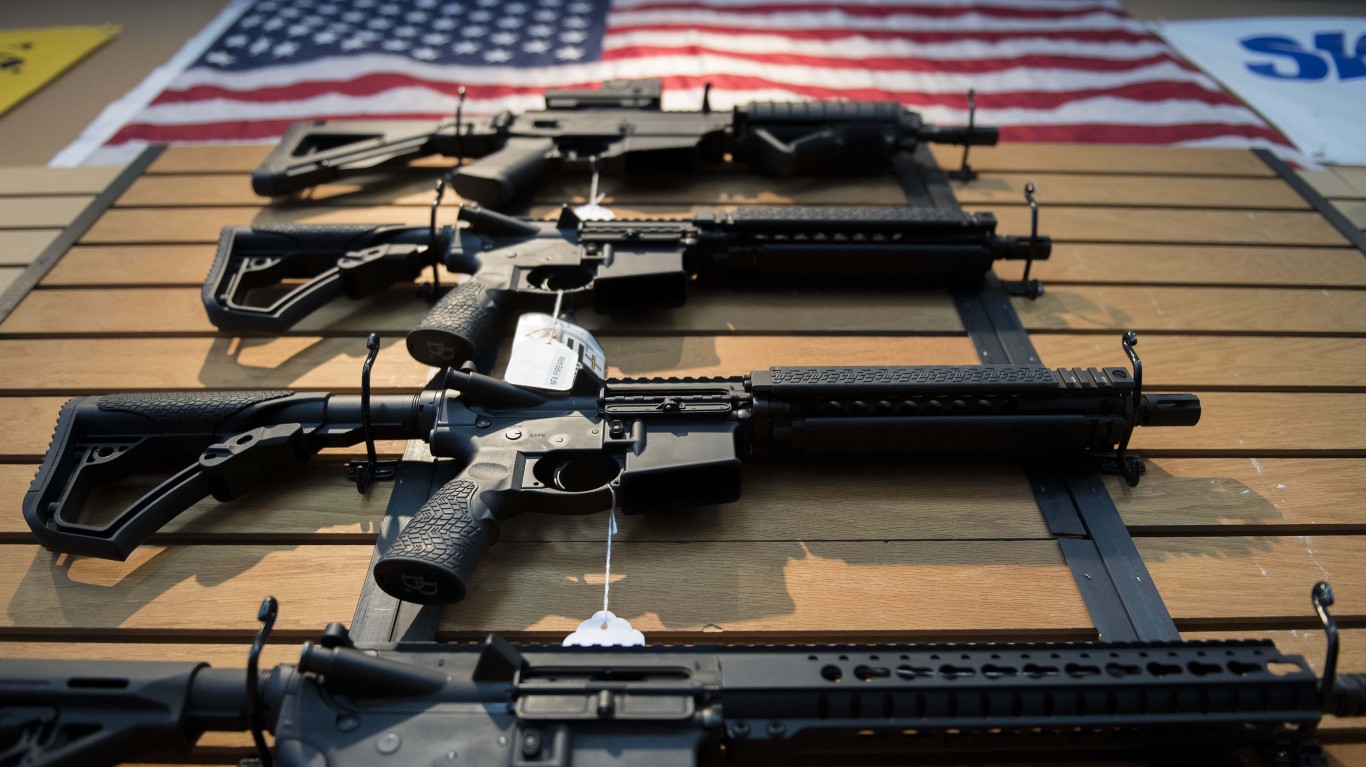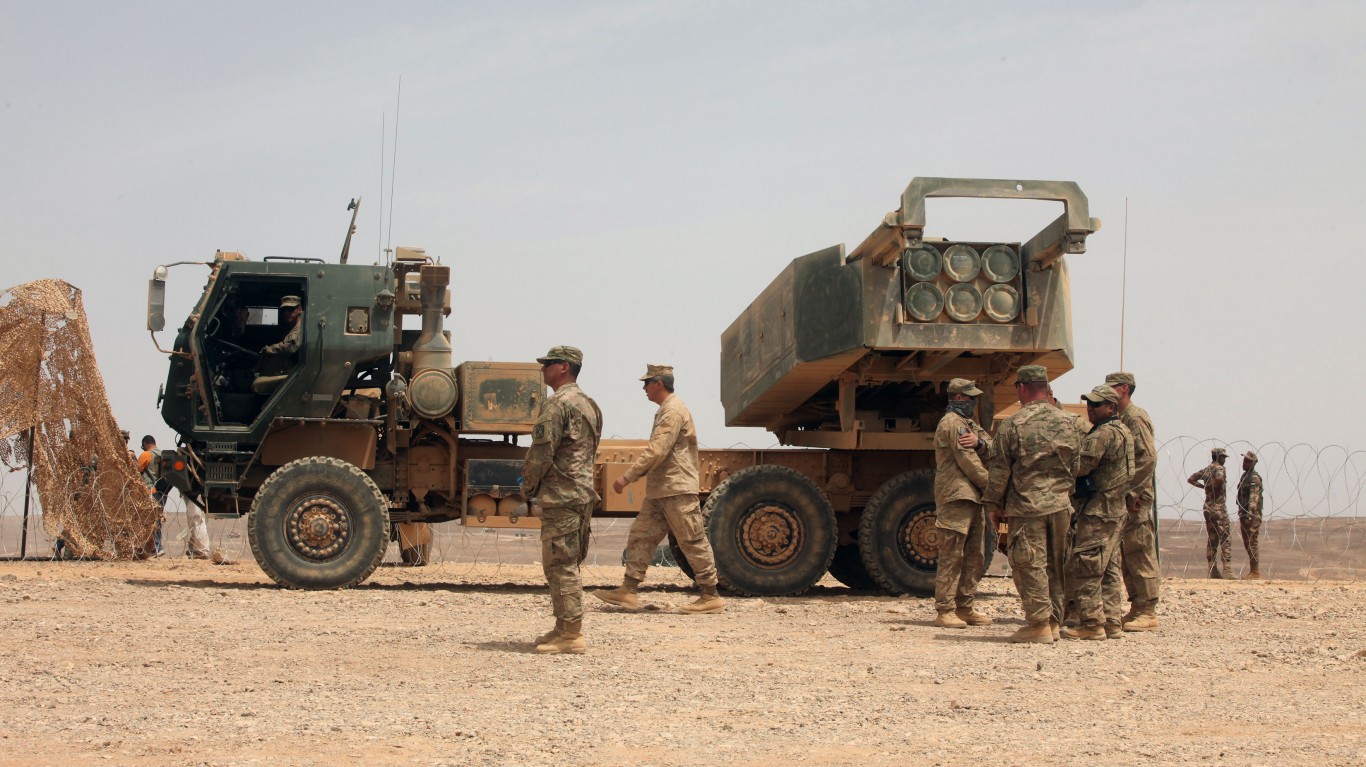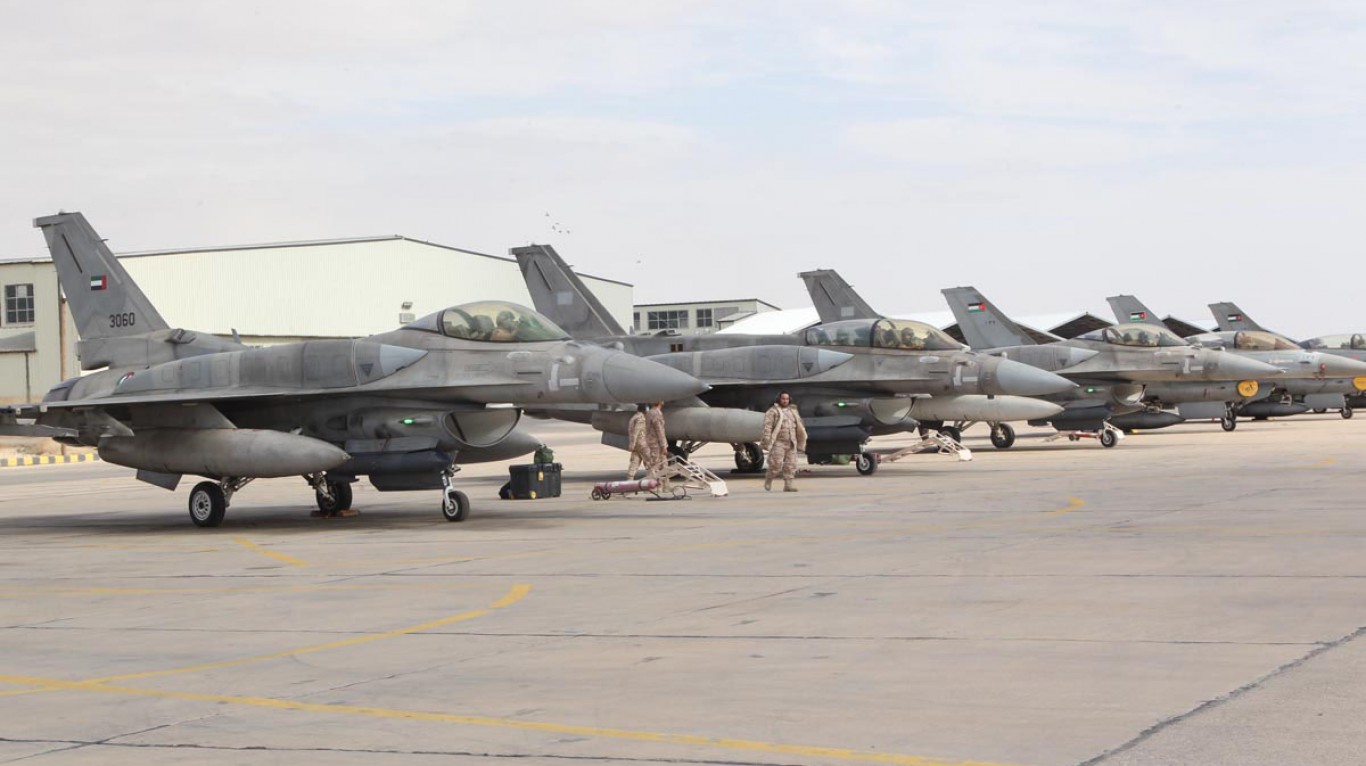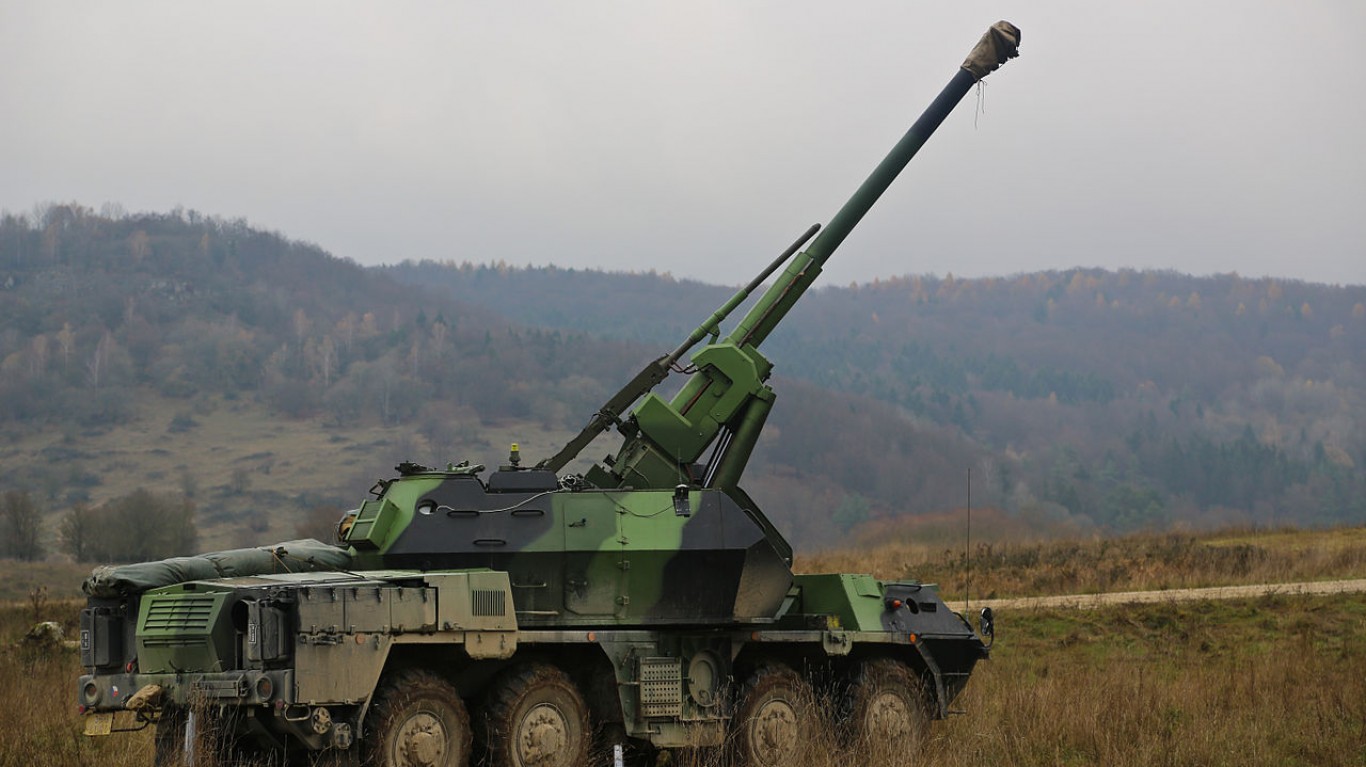
Russia is one of the world’s largest sovereign exporters of weapons. According to a recent report by the publication Foreign Policy, Russia’s planned arms sales to several African nations, primarily Algeria, Angola, Egypt, and Sudan, has been cut significantly as a direct result of the nation’s war with Ukraine. In 2020, worldwide military and defense spending reached an all time high of close to $2 trillion.
Much of this spending went towards arms procurement – the purchase of military equipment including tanks, aircraft, missiles, and other hardware and weaponry systems. Though many countries invest billions of dollars in defense each year, relatively few have private industry that is sufficiently advanced or robust to meet the needs of their own modern military. As a result, nations large and small rely on international trade to equip and supply their fighting forces.
Using data from the Stockholm International Peace Research Institute, or SIPRI, 24/7 Wall St. identified the 25 countries that are the largest exporters of arms. Countries arre ranked on the value of their arms exports as a share of all arms exports globally from 2017 to 2021. The United States and Russia alone account for over half of all global arms exports.
Many of the highest ranking countries on this list are home to some of the world’s largest defense contractors. The United States, which alone accounts for over one-third of global arms exports, is home to each of the five largest defense contractors in the world, including Lockheed-Martin, Boeing, and Northrop Grumman. Here is a look at the 20 companies profiting most from war.
Strategic international alliances are often reflected in the countries that sell arms to one another. For example, about 23% of all U.S. arms exports go to Saudi Arabia, a controversial yet key U.S. ally in the Middle East that has been providing military support to Yemen in their civil war since 2015. Australia and South Korea, the second and third largest buyers of U.S. military exports, are also key American allies. These are the countries buying the most weapons from the U.S. government.
Click here to see the 25 largest exporters of major arms and their main recipients
Click here to see our methodology

25. Jordan
> Share of global arms exports, 2017-2021: 0.2%
> Largest recipient: United States (40% of total)
> 2nd largest recipient: Egypt (36% of total)
> 3rd largest recipient: Armenia (10% of total)
> Annual military expenditure: $2.1 billion (5% of GDP)
[in-text-ad]
24. Czech Republic
> Share of global arms exports, 2017-2021: 0.2%
> Largest recipient: United States (28% of total)
> 2nd largest recipient: Ukraine (26% of total)
> 3rd largest recipient: Uganda (13% of total)
> Annual military expenditure: $3.3 billion (1.4% of GDP)

23. India
> Share of global arms exports, 2017-2021: 0.2%
> Largest recipient: Myanmar (50% of total)
> 2nd largest recipient: Sri Lanka (25% of total)
> 3rd largest recipient: Armenia (11% of total)
> Annual military expenditure: $72.9 billion (2.9% of GDP)
22. Norway
> Share of global arms exports, 2017-2021: 0.3%
> Largest recipient: Oman (27% of total)
> 2nd largest recipient: United States (21% of total)
> 3rd largest recipient: Lithuania (14% of total)
> Annual military expenditure: $7.1 billion (1.9% of GDP)
[in-text-ad-2]
21. Brazil
> Share of global arms exports, 2017-2021: 0.3%
> Largest recipient: France (23% of total)
> 2nd largest recipient: Nigeria (13% of total)
> 3rd largest recipient: Chile (11% of total)
> Annual military expenditure: $19.7 billion (1.4% of GDP)

20. Belarus
> Share of global arms exports, 2017-2021: 0.3%
> Largest recipient: Serbia (34% of total)
> 2nd largest recipient: Viet Nam (25% of total)
> 3rd largest recipient: Uganda (14% of total)
> Annual military expenditure: $844.5 million (1.3% of GDP)
[in-text-ad]

19. South Africa
> Share of global arms exports, 2017-2021: 0.3%
> Largest recipient: UAE (26% of total)
> 2nd largest recipient: United States (21% of total)
> 3rd largest recipient: India (12% of total)
> Annual military expenditure: $3.2 billion (1.1% of GDP)

18. United Arab Emirates
> Share of global arms exports, 2017-2021: 0.4%
> Largest recipient: Egypt (31% of total)
> 2nd largest recipient: Jordan (24% of total)
> 3rd largest recipient: Algeria (15% of total)
> Annual military expenditure: N/A

17. Canada
> Share of global arms exports, 2017-2021: 0.5%
> Largest recipient: Saudi Arabia (47% of total)
> 2nd largest recipient: UAE (22% of total)
> 3rd largest recipient: Australia (6.8% of total)
> Annual military expenditure: $22.8 billion (1.4% of GDP)
[in-text-ad-2]

16. Australia
> Share of global arms exports, 2017-2021: 0.6%
> Largest recipient: Canada (33% of total)
> 2nd largest recipient: Chile (29% of total)
> 3rd largest recipient: United States (18% of total)
> Annual military expenditure: $27.5 billion (2.1% of GDP)
15. Switzerland
> Share of global arms exports, 2017-2021: 0.7%
> Largest recipient: Australia (25% of total)
> 2nd largest recipient: Denmark (12% of total)
> 3rd largest recipient: France (8.7% of total)
> Annual military expenditure: $5.7 billion (0.8% of GDP)
[in-text-ad]

14. Ukraine
> Share of global arms exports, 2017-2021: 0.7%
> Largest recipient: China (39% of total)
> 2nd largest recipient: Thailand (15% of total)
> 3rd largest recipient: Russia (13% of total)
> Annual military expenditure: $5.9 billion (4.1% of GDP)

13. Sweden
> Share of global arms exports, 2017-2021: 0.8%
> Largest recipient: Pakistan (24% of total)
> 2nd largest recipient: United States (24% of total)
> 3rd largest recipient: Brazil (15% of total)
> Annual military expenditure: $6.5 billion (1.2% of GDP)

12. Turkey
> Share of global arms exports, 2017-2021: 0.9%
> Largest recipient: Turkmenistan (16% of total)
> 2nd largest recipient: Oman (16% of total)
> 3rd largest recipient: Qatar (14% of total)
> Annual military expenditure: $17.7 billion (2.8% of GDP)
[in-text-ad-2]
11. Netherlands
> Share of global arms exports, 2017-2021: 1.9%
> Largest recipient: Indonesia (18% of total)
> 2nd largest recipient: United States (16% of total)
> 3rd largest recipient: Mexico (10% of total)
> Annual military expenditure: $12.6 billion (1.4% of GDP)
10. Israel
> Share of global arms exports, 2017-2021: 2.4%
> Largest recipient: India (37% of total)
> 2nd largest recipient: Azerbaijan (13% of total)
> 3rd largest recipient: Viet Nam (11% of total)
> Annual military expenditure: $21.7 billion (5.6% of GDP)
[in-text-ad]

9. Spain
> Share of global arms exports, 2017-2021: 2.5%
> Largest recipient: Australia (51% of total)
> 2nd largest recipient: Turkey (13% of total)
> 3rd largest recipient: Belgium (8.6% of total)
> Annual military expenditure: $17.4 billion (1.4% of GDP)

8. South Korea
> Share of global arms exports, 2017-2021: 2.8%
> Largest recipient: Philippines (16% of total)
> 2nd largest recipient: Indonesia (14% of total)
> 3rd largest recipient: United Kingdom (14% of total)
> Annual military expenditure: $45.7 billion (2.8% of GDP)

7. United Kingdom
> Share of global arms exports, 2017-2021: 2.9%
> Largest recipient: Oman (19% of total)
> 2nd largest recipient: Saudi Arabia (19% of total)
> 3rd largest recipient: United States (19% of total)
> Annual military expenditure: $59.2 billion (2.2% of GDP)
[in-text-ad-2]
6. Italy
> Share of global arms exports, 2017-2021: 3.1%
> Largest recipient: Egypt (28% of total)
> 2nd largest recipient: Turkey (15% of total)
> 3rd largest recipient: Qatar (9% of total)
> Annual military expenditure: $28.9 billion (1.6% of GDP)

5. Germany
> Share of global arms exports, 2017-2021: 4.5%
> Largest recipient: South Korea (25% of total)
> 2nd largest recipient: Egypt (14% of total)
> 3rd largest recipient: United States (6.1% of total)
> Annual military expenditure: $52.8 billion (1.4% of GDP)
[in-text-ad]

4. China
> Share of global arms exports, 2017-2021: 4.6%
> Largest recipient: Pakistan (47% of total)
> 2nd largest recipient: Bangladesh (16% of total)
> 3rd largest recipient: Thailand (5% of total)
> Annual military expenditure: $252.3 billion (1.7% of GDP)

3. France
> Share of global arms exports, 2017-2021: 11%
> Largest recipient: India (29% of total)
> 2nd largest recipient: Qatar (16% of total)
> 3rd largest recipient: Egypt (11% of total)
> Annual military expenditure: $52.7 billion (2.1% of GDP)

2. Russia
> Share of global arms exports, 2017-2021: 19%
> Largest recipient: India (28% of total)
> 2nd largest recipient: China (21% of total)
> 3rd largest recipient: Egypt (13% of total)
> Annual military expenditure: $61.7 billion (4.3% of GDP)
[in-text-ad-2]

1. United States
> Share of global arms exports, 2017-2021: 39%
> Largest recipient: Saudi Arabia (23% of total)
> 2nd largest recipient: Australia (9.4% of total)
> 3rd largest recipient: South Korea (6.8% of total)
> Annual military expenditure: $778.2 billion (3.7% of GDP)
Methodology:
To identify the world’s 25 largest arms exporters, 24/7 Wall St. reviewed data from the Stockholm International Peace Research Institute. Countries are ranked on the value of their arms exports as a share of all arms exports globally from 2017 to 2021. We also included SIPRI data on the three largest recipient countries for each exporter, ranked by the share of arms purchased. Percentages below 10 are rounded to 1 decimal place; percentages over 10 are rounded to whole numbers. Supplemental data on annual military expenditure in current U.S. dollars and military spending as a share of GDP are also from SIPRI and are for 2020, the most recent year for which data is available.
Get Ready To Retire (Sponsored)
Start by taking a quick retirement quiz from SmartAsset that will match you with up to 3 financial advisors that serve your area and beyond in 5 minutes, or less.
Each advisor has been vetted by SmartAsset and is held to a fiduciary standard to act in your best interests.
Here’s how it works:
1. Answer SmartAsset advisor match quiz
2. Review your pre-screened matches at your leisure. Check out the advisors’ profiles.
3. Speak with advisors at no cost to you. Have an introductory call on the phone or introduction in person and choose whom to work with in the future
Thank you for reading! Have some feedback for us?
Contact the 24/7 Wall St. editorial team.






 24/7 Wall St.
24/7 Wall St.

